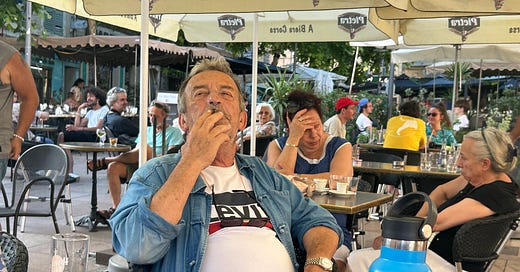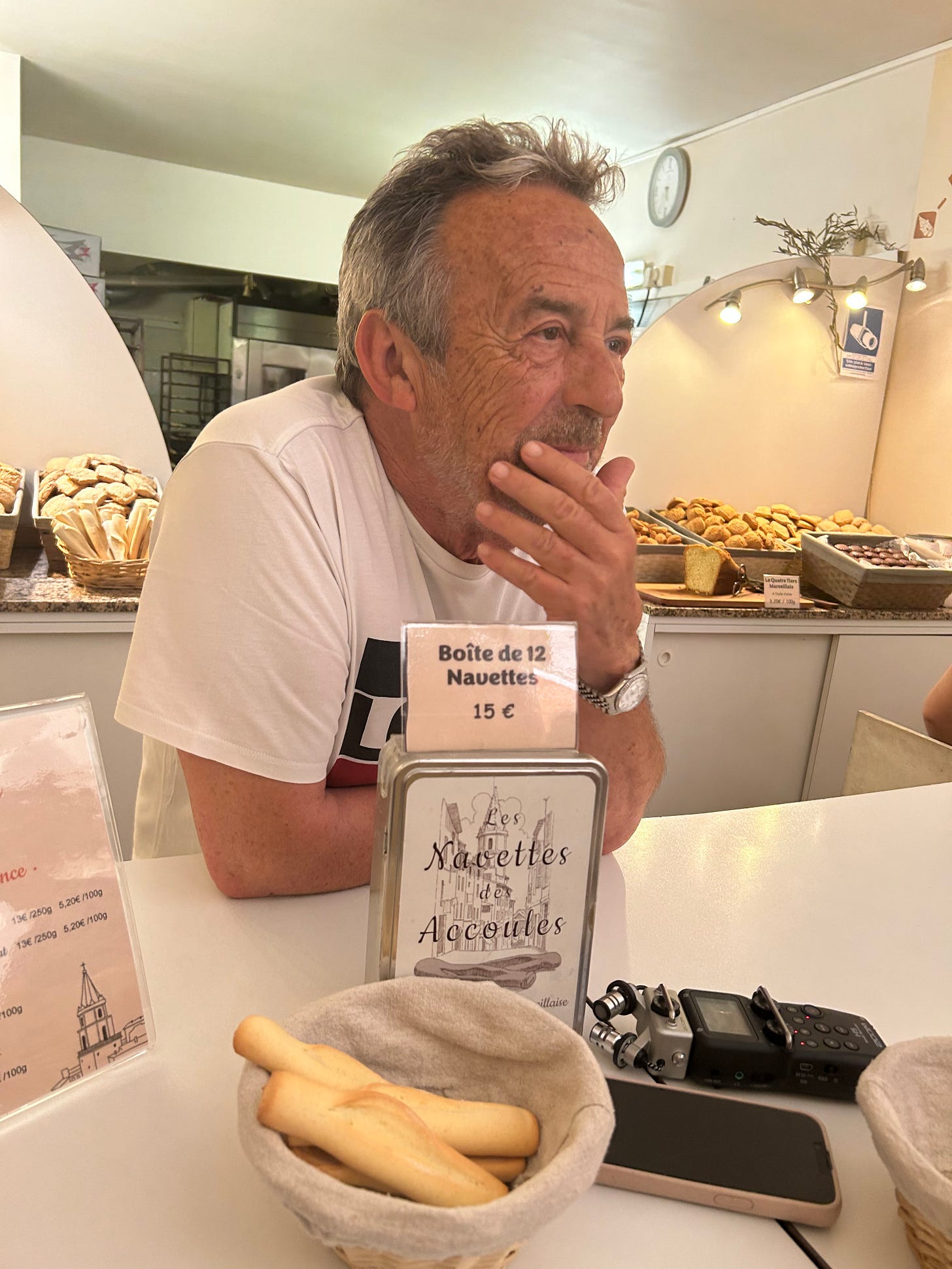The master cookie-maker of Marseille and other tales from the Vallée de la Gastronomie
By Sasha Paulsen
We asked Sasha to write about her recent excursion to France, and we are glad we did. Happy Bastille Day (July 14).
MARSEILLE, France — In the late afternoon we were sitting at an outdoor cafe atop a hill in Marseille with José Orsoni, a veteran baker whom we’d met minutes earlier at his bakery, Les Navettes des Accoules. Orsoni, a grizzled Frenchman with a hearty laugh and twinkling eyes, had come out from the back of his hole-in-the-wall bakery when we arrived, four American journalists and our guide.
“You want to watch me bake?” he asked. “At 5 in the afternoon? You have to come at 5 in the morning.”
Instead, he gave us samples of his cookies, first Navettes de Marseille -- hard, canoe-shaped biscuits. He makes them with the recipe of his Corsican grandmother, who opened the bakery he now runs.
According to legend, navettes represent the boat that brought St. Lazarus, St. Mary Magdalene and St. Martha to Maries-la-Mer in Provence 2,000 years ago. While they are tasty, they are also tough enough to have sailed across the Mediterranean. Sailors can keep them onboard their ships for six months and they’ll still be good, Orsoni said.
“When do you eat them?” one of our group asked.
“When?” he asked. “Whenever you want. You can dunk them in your coffee in the morning.” He paused. “Or you can dunk them in your glass of wine.”
“Really?” This was a chorus of four writers.
“Sure,” he said. “Wait — come on with me.”
He closed his shop for the day, and we followed him across the street to the cafe. While we sat beneath the leafy trees, carefully dunking our navettes in glasses of white wine, everyone came by to greet him: two young girls to show him the special makeup they were wearing to the Beyonce concert that night, two elderly ladies pausing for an aperitif and conversation, his daughter and son-in-law with his two grandchildren, one brand-new. They would be taking over the bakery, Orsoni said. But not yet.
“Do you want to retire?” one of our group asked.
“Me?” he asked. “Why? If I did that, I wouldn’t be sitting here with you.”
There was the laugh, the twinkle, and the knowledge that we couldn’t be anywhere but in France.
We were on the last day of a weeklong journey arranged by Atout France, the French tourism development agency. Our mission? To explore the newly created Vallée de la Gastronomie, a collaboration between three regions -- Burgundy, Auvergne-Rhone-Alpes and Provence -- to showcase their glorious bounty of food and wine.
In effect, they’ve created a 385-mile journey “pour les explorateurs du goût” — explorers of taste — all in one choose-your-adventure website. To date they have some 460 possibilities to consider. Do you want to work in a harvest for the day or taste wine at a chateau? Meet makers of nougat or go to a sea-urchin festival? Visit a snail farm or a historic herbalist’s shop? Or find that off-the-beaten path restaurant you will never forget? It’s a journey through the gastronomic heart of France just to peruse the 39-page Vallée de la Gastronomie website, which provides links to make reservations.
In our case the organizers had made the choices for us. With an itinerary and a driver, off we went. First we spent a night in Dijon, staying at the historic Grand Hotel La Cloche, which combines Beaux Arts mystique with modern comfort and also serves an exceptional breakfast. Their offerings include a lavish selection of fresh fruits and preserves, Dijon specialties (cassis, mustard), cheeses, sausages and breads of all kinds, in addition to the omelets, crepes and, if you really want this, a bowl of cereal. When people ask, “What was the beat meal you had in France?” there is a temptation to say, “It might have been breakfast in Dijon.”
Which is not to say there weren’t other great meals ahead. Before that, however, we visited Dijon’s new museum, La Cité de la Gastronomie et du Vin. Built on the site of a medieval hospital, it includes a village of shops and an impressive tasting room with three walls of wines to try, as well as a secret cellar with the grand cru wines. We each had a card worth 15 euros of credit, and our guide admonished us to “See how many wines you can taste.” I have to admit I spent my entire card for one taste of a Gevrey-Chambertin Clos Saint Jacques. It was worth it.
As part of the museum, the Chapelle Sainte-Croix de Jérusalem, built in 1459, has been converted into an exhibition where displays describing the climats de Bourgogne are set amidst ancient statues with dramatic lighting. It is at once mystical and informative and a striking contrast to the main new ultramodern exhibit hall.
Over the next days we went truffle-hunting in a forest above Nuits-Saint-Georges (and had a truffle feast afterward), stopped for a glass of wine at the Chateau de Chamirey, got a cooking lesson with a chef from the three-Michelin-star Maison Pic in Valence and followed a spelunker deep into a cave in the Ardèche to taste wine from Domaine Notre Dame de Cousignac, whose winemaker plays jazz for fermenting wine. We had dinner at a villa outside Aix-en-Provence, met the famous white cows of Charolais, and went out on a fishing boat from the harbor in the Camargue, where we met an octopus. (No one’s dinner, it went back into the sea).
All in all we went to 19 experiences, which leaves 441 yet to explore in the Vallé de las Gastronomie, but whether we were touring a grand chocolate factory or tiny village shop that provides oils to the famous chefs of France, what I carried away, in addition to bags of spices, oil, vinegar and biscuits, were the conversations, each one a story in itself.
Which brings us back to the cookie-maker of Marseille. When Orsoni had finished his wine, he took his leave; he was treating his staff to a party on a boat that night. We went on to meet the official tourist representative for Marseille at the 1860 Le Palais restaurant in the old port for our last meal (for the time being) in France. Over bowls of bouillabaisse we told her about our great discovery, dipping navettes into our wine.
Her face took on an expression of polite confusion.
“You did what?” she asked.
She lives in Marseille but had never heard of this tradition.
“I hope,” she said earnestly, “that he was not — what is it you say? — pulling the legs.” And then, providing entertainment for the other guests at the cafe on a summer evening, “I will research this and find out.”
To date I have not yet heard the results of her inquiry, but as far as I am concerned, when I am next in Marseille I am going to dunk my navettes in my glass of wine. Maybe, however, not the Gevrey-Chambertin Clos Saint Jacques.
Bastille Day
If you, like me, have a fondness for all things French, there are local options for celebrating Bastille Day on July 14. Among them, Dan Dawson’s Outer Space Wines will be pouring French wines, and a bit farther afield, in Winters, L’Apéro les Trois is hosting a French style grillade of sausages and lamb from 6 to 7 p.m. that day. Noted Francophile Georgeanne Brennan is one of the trio who opened this charming tasting room, which she calls “French style with a California twist.” To talk to her is yet another conversation to remember, another story.
Editor’s note: The Alliance Française de Napa is hosting a party to celebrate La Prise de la Bastille on Sunday the 16th — check their web site for information.
Sasha Paulsen is a journalist and novelist who lives in Napa.










Great article about the Vallée de la Gastronomie -- worth mentioning, the Alliance Française de Napa is hosting a party to celebrate La Price de la Bastille on Sunday the 16th -- check their web site for information.
I so enjoyed reading this article. Thank you, Sasha!